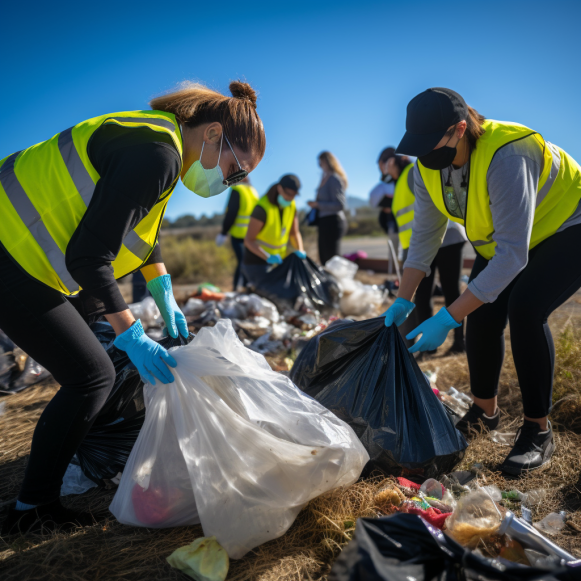Beach bounce back? California’s largest volunteer event seeks to restore former glory after COVID downturn

39th annual Coastal Cleanup Day is this Saturday, and looking for more helpers to pick up litter
It is California’s largest annual volunteer event, with tens of thousands of people flocking to beaches, rivers, and lakes across the state every September since 1985 to pick up tons of trash, beautify the environment, and help protect wildlife.
Coastal Cleanup Day, which takes place this Saturday from 9 a.m. to noon at 695 locations, is struggling to recover from the COVID pandemic, as are downtown office buildings and public transportation.
“We’ve been gradually increasing volunteer numbers,” said Eben Schwartz, marine debris program manager at the California Coastal Commission, which oversees the event. “We’re resuming operations at our previous size.” But I believe it will take time.”
Before COVID, 74,410 volunteers picked up 918,000 pounds of litter in 2019.
Due to the pandemic, there was no organized coastal cleanup in 2020. And, despite the return of the traditional cleanup day in 2021 and 2022, turnout last year was still only 38,467 people — roughly half of what it was before COVID. They collected 308,540 pounds of litter, which was roughly one-third of the pre-COVID total.
Organizers say they’re not sure why.However, they observe that people have fallen out of the habit of participating every year, whether through a community group, family and neighbors, or an employer-sponsored project. Some nonprofit leaders who assisted with local cleanups left their positions.
“I feel like everyone is slowly getting back into volunteer mode,” said Jen Vanya, a spokeswoman for the East Bay Regional Park District, which is organizing cleanups in Alameda and Contra Costa counties on Saturday. “People are more at home than they used to be.”
This year, the Coastal Commission has launched a paid social media campaign and is working tirelessly to restore one of California’s most important environmental traditions.
There will be events in at least 55 of California’s 58 counties, with the exceptions of Sutter, Siskiyou, and Trinity counties.
Volunteers are welcome at nearly all of the locations, including popular coastal beaches, San Francisco Bay, and inland lakes and streams. In many cases, all they need to bring are gloves. The event is scheduled to take place as summer transitions into fall. Trash is removed from waterways in this manner before the first rains of winter flush it into the ocean and bays.
Since the event’s inception in 1985, more than 1.7 million volunteers have removed over 26 million pounds of trash from California’s outdoors.
The debris, particularly the plastic, not only makes the state’s beaches look unsightly, but it can also kill wildlife such as birds and sea turtles that become entangled in it or eat it.
Volunteers collect food wrappers, bottles, cans, cigarette butts, and other debris, noting the type and number of items collected so that the Coastal Commission can track pollution trends. Every year, they also discover a slew of bizarre garbage.
“Last year, someone discovered a trophy.” It was quite amusing. “It was the 2006 best couples ice skaters trophy,” Vanya explained.
Volunteers removed a couch from Martin Luther King Jr. Regional Shoreline Park in Oakland.
California law changes have had an impact on the type of litter found on beaches.
Governor Gavin Newsom signed legislation prohibiting smoking on state beaches and state parks four years ago, with fines of up to $25 per violation. Cigarette butts, nearly always the most abundant item found each year by volume, fell to 26% of the total litter last year, down from an average of 35% to 40% in previous years.
Plastic bags have also decreased since former Governor Jerry Brown signed legislation prohibiting the use of plastic grocery bags in an effort to reduce litter and ocean pollution in 2014. The law was upheld by voters, who rejected a challenge from the plastic bag industry.
Plastic grocery bags accounted for 8.7% of the litter found in California during coastal cleanup days in 2009.They were only 1.4% last year.
Coastal cleanup days in other states are also finding fewer volunteers than before the COVID pandemic, according to Schwartz, who added that restoring the event to its previous size and effectiveness will require people who care about the outdoors and the state’s environment.
“You could be one person on a beach for a few hours picking up 10 pounds of trash,” he explained. “However, you are one of dozens on that beach, and one of tens of thousands across the state, all participating in the same activity at the same time, creating a massive collective impact.”
“This event has repercussions that will be felt throughout the year.”
Go to www.coastalcleanup.org to see where organized cleanups are taking place.




